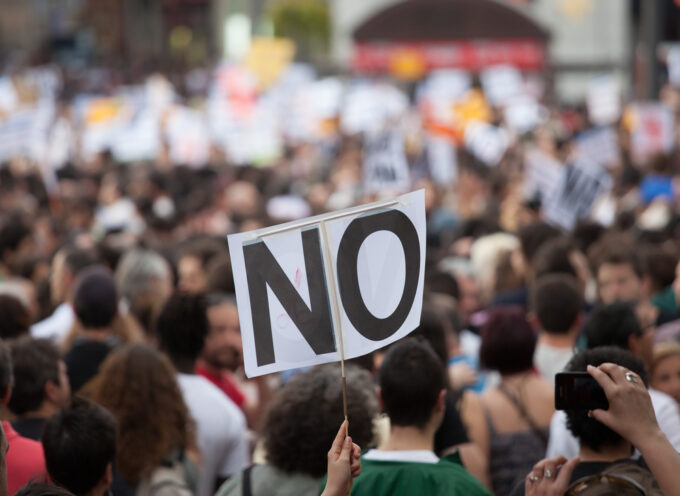In the twenty-first century, war has morphed into something historically unrecognizable. Our conflicts are qualitatively and quantitatively unlike those in the past. What’s more, war will morph even more in upcoming years. Today’s wars are more about cultural and religious animosity than enlargement of borders or rectification of injustice. Further, rapidly developing technologies have not been accompanied by ethical reflection on the proper use of those technologies.
One such technology is unmanned aerial vehicles (UAVs) or unmanned aircraft systems (UAS) which, in this article, will be referred to as drones. Drones can be fully autonomous but usually are partially autonomous, flown remotely by a human pilot. On the positive side, use of drones allows our nation to target and kill enemy combatants who otherwise would be difficult to kill, while maintaining a smaller risk to our own troops and non-combatants in the vicinity of the attack. On the negative side, there are questions about the morality of using drones to kill in arenas where there is no declaration of war and of using a form of warfare in which there is no risk to ourselves.
Thus, this brief article will summarize briefly some of the merits and risks of using drone technology in military conflict. Specifically, we will address the contexts of drone warfare, the “targeting,” in drone warfare, the asymmetric risk allocation inherent to drone warfare, and the just war principles of proportionality and discrimination in relation to drone warfare.
The Contexts of Drone Usage
The United States has used drones in various types of conflicts: against insurgencies in which Western nations have been formally at war with specific insurgent groups (Taliban in Afghanistan, Saddam regime in Iraq); against insurgents in support allies who are engaged in an armed conflict (i.e. in support of various factions against Ghaddafi’s forces in Libya, in support of Kurdish forces and against various groups in Syria and Iraq, etc.); and in targeted killing of non-state actors in order to reduce risk to Western nations’ security (i.e. against Al-Qaeda in Pakistan and Yemen, Al-Shabaab in Somalia, and Boko Haram in Nigeria).
The first context is the use of drones in conflicts in which a nation is formally at war with the targeted combatants or that the targets are allied with combatants against whom a nation is at war. This type of drone use is less problematic than others we’ll consider. In this context, the use of drones is presumably governed by rules of engagement (ROEs) based on just war principles, allowing for enemy combatants to be targeted and killed as long as the criteria of proportionality and discrimination are met. Proper use of drones in this manner would be akin to manned airstrikes or targeted killings by a sniper team.
A different, and more problematic, use of drones occurs in contexts outside the formal theater of war, where operations are often described as “policing.” In the context of war, drones target individuals out of self-defense or defense of others. However, outside of formal warfare, the targeting of individuals becomes more difficult to justify. Some argue that targeting terrorist groups and insurgents in non-war zones should be classified as a policing action subject to legal and judiciary constraints. In other words, with police actions, killing is only allowed after a judicial determination of guilt or in self-defense in situations of great risk to life or injury. In a war, on the other hand, the threshold of considering a combatant a threat to life is much lower, and killing is allowed in relation to any person who has the status of “combatant.” In the case of targeted drone strikes not conducted in formal war zones, however, the combatants may have no judicial pronouncement of guilt, nor pose a direct risk and immediate risk to nation employing the drone or its allies. Accordingly, drone killings would seem to be akin to extrajudicial killings by government actors.
However, not all drone warfare against terrorists who are not in a formal theater of war should not be equated with “police action.” It is not essentially the same as domestic police action in all cases. In some instances, it is a hybrid between formal warfare and domestic police action in which, by virtue of a terrorist’s proclaimed intent to harm non-combatants, preemptive force can be justified on the basis of the right to self-defense of a nation or its allies. Thus, force can be justified outside of a formal theater of war if it is in response to a genuine threat by non-state actors and it is carried out within a limited scope. For example, we can imagine a justified use of drone warfare against a confirmed terrorist bomb-making facility somewhere in the world.
The “Targeting” Inherent in Drone Warfare
The ability to justify use of force in non-war contexts raises the question of the specific targeting of individuals. The U.S. currently engages in two types of targeted killings with drones: (1) personality strikes, which are carried out against known individuals who are on a kill-list compiled and cross-checked by various intelligence services and authorized by the White House; and (2) signature strikes, in which individuals are targeted who meet a “signature” or profile, such as being within a known combat zone, being male and of fighting age, grouped in 4 or more individuals, conducting suspicious activity, etc. The first type of strike can be carried out justly and with confidence. The second type of strike is much more complicated and sometimes cannot be carried out with confidence that it is just, given the threat of actually killing innocent non-combatants is much more likely.
Asymmetric Risk Allocation
Some critics of drone use for targeted killings argue that the use of drones as such is problematic because of the extreme asymmetry involved. In the first case, the problematic feature of introducing asymmetry is said to be that it contravenes the jus in bello principle of proportionality, for the act is not proportionate to the threat latent in the enemy combatants and the unfortunate secondary effects of drone warfare, such as terrorizing local civil populations with the constant threat of unforeseen strikes, etc.
Further, other critics argue that with drone operators experiencing no risk in the act of killing, operators don’t experience the gravity of their act and are thus more likely to make improper judgments. Some critics, such as Paul Kahn, argue that the relationship between two combatants which renders it morally permissible to kill each other in the context of war is that war presumes a different ethic than everyday life which is predicated on the mutual experience of risk which allows for use of force in actions of self-defense. Yet, this criticism rests on faulty assumptions. It is not morally wrong to attack combatants who do not pose an immediate threat to the opposing force. Latent threats are sufficient to target an enemy combatant.
There needs to be serious investigation into the potential negative effects of using drone operators who are thousands of miles away, who are often living everyday lives intermingled with civilians, without risk to themselves in the operation of drones. This separation from the theater of war may very well lower inhibitions on the part of the state at large and the operator in particular.
Proportionality and Discrimination
Those who support the use of drones often point out that they can be more proportionate and discriminating uses of force for the goals of an operation than other conventional uses of force. By this, they mean that the risk of harm to non-combatants is lessened because of the ability of drones to target specific individuals using very small explosives which reduce the blast radius. Thus, the argument is that such strikes are understood to be inherently more discriminatory.
Critics of drones, however, argue that drone strikes are not necessarily more discriminatory or proportionate. According to them, data reveals them to be not very discriminating and not necessarily more proportionate. The data is murky, but the consensus of third party investigators is that the civil deaths from drone strikes is woefully high.
Additionally, discrimination in the just war tradition refers to the ability to determine combatant from non-combatant, not the technical ability to avoid harming non-combatants. The current strategy of signature strikes means drone strikes can be less discriminating than other forms of force. Also, the ill psychological effects of drone usage on society and government may be disproportionate to the gains made by using drones to kill specific individuals. For instance, drone attacks might make it very difficult to win the psych-ops battle, with the hearts and minds of local populations less likely to trust us.
Naked Soldiers and Terrorists
The final critique comes from those who see the targeting of terrorists via drone strikes as analogous to the problematic features of targeting “naked soldiers”. The naked soldier discussion concerns the morality within the just war tradition of intentionally targeting a known combatant when he or she is most vulnerable or not definitively identifiable as a combatant, and therefore not posing any threat. In response, I argue that naked or sleeping soldiers still possess the ability to threaten others, even if not at that moment, and therefore we are justified in assuming they are consenting supporters to the war effort. They are “fair game.”
Regarding terrorists, drone strikes target them most often when they are not engaged in threatening activities. Is it permissible to target them and on what basis? As most strikes are currently performed outside the context of a traditional war, one must justify why it would be permissible to kill rather than apprehend those individuals. One justification is that they pose a significant threat to others by their continued actions, having participated already in the harming of innocent civilians. Another justification is that intelligence data makes clear that the persons under question pose an imminent threat. Finally, both of these justifications presume that domestic police forces are either unable to mitigate the threats posed by these individuals, or have no functional jurisdiction over them.
Conclusion
In summary drone warfare is not inherently unjust. Drone warfare, however, is subject to the same just war principles that we apply to other forms of warfare: conventional warfare, nuclear warfare, direct action operations, surrogate warfare, cyberwarfare, and so forth. If these principles are ignored, we will see unnecessary killing of civilians, reliance on shaky intelligence, murky oversight of kill lists, lowering of the threshold for use of force abroad, and mistrust of our nation by the local communities whose hearts and minds we wish to win.
Other Articles in the “Ethics of Warfare” Series
1. To Fight or Not to Fight? That is the Question.
2. What Kind of Peace Should America Seek in our War-Torn Era?
3. Why I am Peaceful but Not a Pacifist
5. Why I am a Proponent of the Just War Tradition
6. The “Founding Fathers” of the Just War Tradition
7. Seven All-Stars of the Just War Tradition
8. Eight Recent Champions of the Just War Tradition
9. 8 Criteria for Deciding When It’s Right to Go to War
10. 7 Moral Criteria to Guide Commanders during Battle
11. How Do Just War Principles Apply to Terrorism & Asymmetrical Warfare?
12. How Do Just War Principles Apply to Drone Warfare?
13. Future War: How do We Prepare Ethically for Radically New Forms of Warfare on the Horizon?
14. The Ethics of Special Operations Warfighting
Subscribe
Never miss a post! Have all new posts delivered straight to your inbox.







